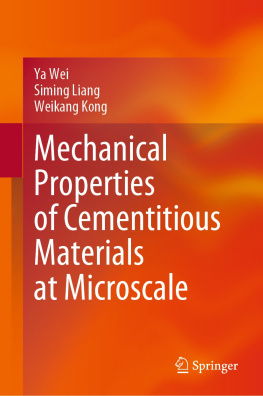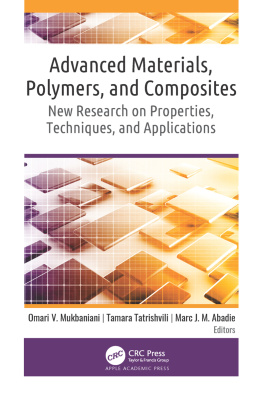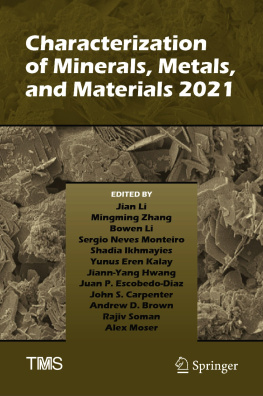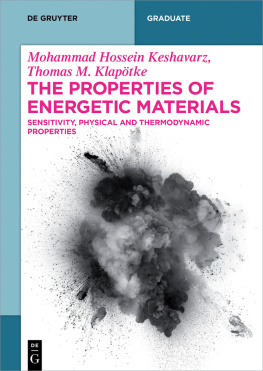Contents
Pagebreaks of the print version
Composites and Metamaterials
Composites and Metamaterials

Roderic Lakes
University of Wisconsin-Madison, USA

Published by
World Scientific Publishing Co. Pte. Ltd.
5 Toh Tuck Link, Singapore 596224
USA office: 27 Warren Street, Suite 401-402, Hackensack, NJ 07601
UK office: 57 Shelton Street, Covent Garden, London WC2H 9HE
Library of Congress Cataloging-in-Publication Data
Names: Lakes, Roderic S., author.
Title: Composites and metamaterials / Roderic Lakes, University of Wisconsin-Madison, USA.
Description: New Jersey : World Scientific, [2020] |
Includes bibliographical references and index.
Identifiers: LCCN 2019057935 | ISBN 9789811216367 (hardcover) | ISBN 9789811216374 (ebook) |
ISBN 9789811216381 (ebook other)
Subjects: LCSH: Composite materials--Mechanical properties. |
Metamaterials--Mechanical properties.
Classification: LCC TA418.9.C6 L35 2020 | DDC 620.1/18--dc23
LC record available at https://lccn.loc.gov/2019057935
British Library Cataloguing-in-Publication Data
A catalogue record for this book is available from the British Library.
Copyright 2020 by World Scientific Publishing Co. Pte. Ltd.
All rights reserved. This book, or parts thereof, may not be reproduced in any form or by any means, electronic or mechanical, including photocopying, recording or any information storage and retrieval system now known or to be invented, without written permission from the publisher.
For photocopying of material in this volume, please pay a copying fee through the Copyright Clearance Center, Inc., 222 Rosewood Drive, Danvers, MA 01923, USA. In this case permission to photocopy is not required from the publisher.
For any available supplementary material, please visit
https://www.worldscientific.com/worldscibooks/10.1142/11715#t=suppl
Desk Editors: Tay Yu Shan/Nur Izdihar Binte Ismail
Printed in Singapore
Preface
This book is intended to be of use in a one semester course on the structure and properties of materials that are heterogeneous on size scales larger than the atomic and the nano. Emphasis is placed on mechanical properties; also the coupling of elastic behavior with electric and thermal variables. Draft manuscript materials have been used for an interdisciplinary course for senior undergraduate students and graduate students in materials science, mechanics, biomedical engineering, and mechanical engineering. The assumed prerequisite subjects include introductory university physics and a course in the mechanical properties of materials. Sections on novel classes of materials with unusual or extreme behavior are intended both for students and for researchers.
As for materials, both well-established materials and also novel materials that have been popular in a research setting are presented. For established materials, selected applications are presented. The intent is not to be encyclopedic. Lamination theory, for example, is a substantial part of many composites courses and is thoroughly covered elsewhere. In the present book, this subject is summarized briefly. To help clarify the flow of ideas, primary references are used when they are known, and the evolution of the thought process is outlined.
Solved problems are provided for instructional use; also problems without solutions. Supplementary material, resources for instruction and research links are provided in the following web site.
http://silver.neep.wisc.edu/~lakes
I thank colleagues in the Department of Engineering Physics and Department of Materials Science at the University of WisconsinMadison for encouragement and support during a portion of the time this book was in preparation. I am also grateful to my wife Diana for her patience and support.
Contents
Chapter 1
Introduction
1.1Heterogeneous materials
1.1.1Overview
Composite materials are heterogeneous materials which contain two or more distinct constituent materials or phases, on a microscopic or macroscopic size scale larger than the atomic scale, and in which physical properties are significantly altered in comparison with those of a homogeneous material. In this vein, fiberglass and other fibrous materials are viewed as composites, but alloys such as brass are not. Semi-crystalline polymers such as polyethylene, as well as eutectics, polycrystalline metals, have a heterogeneous structure which can be treated via composite theory. Biological materials such as bone, tendon and muscle, and geological materials such as rocks and minerals also have a heterogeneous structure and are known as natural composites. Composites may contain solid, liquid, and gas phases. For example, composites of gas and liquid include mist and foam; composites of solid and gas include foam and smoke. Composites with a structural role have several solid phases or a connected solid phase with gas or liquid in the interstices (as in cellular solids such as structural foam and honeycomb). Lattices comprise a class of cellular solids in which there is a repeated pattern of cells. Many composites are anisotropic: their properties depend on direction. Anisotropy of properties arises from structural anisotropy. Fibrous composites with fully or partially aligned fibers can be highly anisotropic. Fibers used in composites are much stronger than bulk materials because they can be prepared with few defects. Composites are of particular interest in applications for which density [] is important in relation to physical properties.
Materials may have a variety of physical properties that are coupled. Such coupled fields are of scientific interest; they are also the basis of many practical applications including sensors, actuators and devices to extract energy from the environment (energy harvesting).
Analytical study of composite materials has been done for more than 100 years [] in 1873 reported an analysis of the conductivity of an array of conducting spheres in a conducting matrix.
Composite materials are useful because they may combine beneficial characteristics of the constituent materials or they may provide characteristics not present in the constituents. For example, wood is stiff and strong in one direction only. To improve properties in other directions, plywood is made: the wood is cut in layers which are cemented together in different directions. The resulting plywood is relatively stiff and strong in two directions along the plane of the board. Also, it is possible in composites to achieve physical properties greater than that of any constituent. In heterogeneous materials one can also achieve unusual behavior such as negative physical properties, or extreme behavior.
1.1.2Classification and terminology
Some terminology and neologisms have emerged regarding heterogeneous materials. Smart materials are materials designed such that one or more properties can be altered or controlled by field variable stimuli. These stimuli include but are not limited to stress, temperature, humidity, fluid pressure, pH, electric field, and magnetic field.











